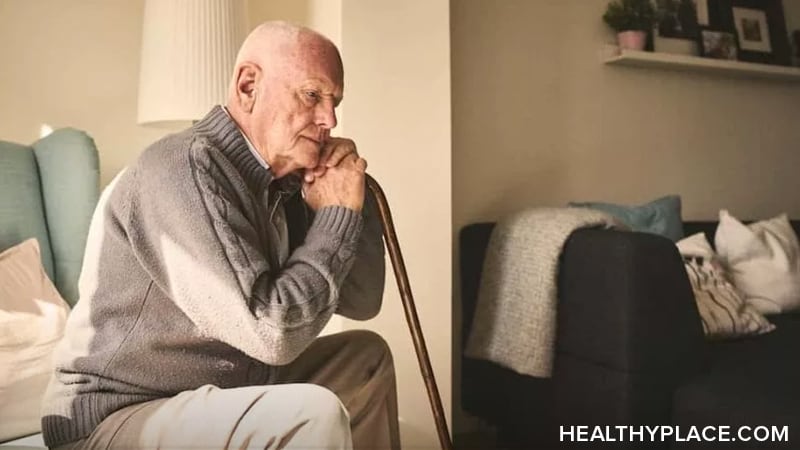Why Depression in the Elderly Can Be So Dangerous

Depression in the elderly, also known as geriatric depression, isn’t a normal part of aging. Major depression is an illness no matter what age it strikes, and it can have dire consequences on quality of life. While it’s not inevitable that someone will develop depression in their later years, they can and do. The Centers for Disease Control and Prevention (CDC, 2017) reports that up to five percent of independent older adults experience major depression, while 11.5 percent of those hospitalized and 13.5 percent of those requiring home care live with depression. Depression in the elderly can be dangerous. Here’s what you need to know.
Reasons Why Depression in the Elderly Can Be So Dangerous
To be sure, aging isn’t a negative process. It is a normal part of human growth and development that can be very positive. The senior years, though, do bring unique changes and challenges that can contribute to major depression.
Declining health can be a complicated contributor to depression. Health problems and aches and pains can limit activities and lead to isolation, both possible causes of major depressive disorder. Depression sometimes co-occurs with a serious illness like heart disease, diabetes, cancer, Alzheimer’s disease, and Parkinson’s disease. Also, depression can be a side-effect of medications taken for these and other illnesses, which is worsened by the fact that medication side effects increase with age (Bihari, 2019).
Major depression is closely connected with illness as well as age-related changes like vision and hearing loss. Declining health and sensory functioning can cause someone to withdraw from people and activities once enjoyed. Isolation and loneliness increase the risks and effects of depression as well as make it difficult for someone to reach out for help.
The changes that come with aging, while not always negative, can feel like a loss. Loss comes in many forms:
- The death of friends and family members
- Retirement, especially when it removes someone’s sense of purpose
- Moving out of a lifelong home
- Loss of mobility
- Loss of independence
The more of these factors someone faces, the greater their depression risk. For multiple reasons, depressions in older adults can be dangerous.
Dangers of Depression in the Elderly
Depression in older adults can
- Make existing illnesses more severe
- Be masked by other illnesses, preventing proper treatment and worsening symptoms
- Cause disability and loss of freedom
- Lead to premature death
- Cause suicidal behavior and death by suicide
Depression and suicide are of great concern, as people over age 65 account for over 25 percent of all suicide deaths in the United States according to the Geriatric Mental Health Foundation (n.d.) This group further informs us that the population with the greatest suicide risk is comprised of white men over the age of 80. The National Institute of Mental Health reinforces the risk of depression and suicide in the elderly: According to the NIMH, the highest suicide rate in the US is found in people over the age of 85, just slightly lower than the rate among adults 45 to 65 years.
Unfortunately, geriatric depression is often overlooked or its importance minimized. Some people brush it off as just a typical part of aging. Increased isolation and loneliness increase someone’s chances of depression as well as make it harder to reach out for support. The older generation, too, is less willing to talk about their feelings or ask for help than their younger counterparts, making it hard for their loved ones to recognize depression.
Recognizing depression is further complicated because depression can appear differently in the elderly than in other age groups. Knowing the signs of depression late in life is crucial.
Signs and Symptoms of Depression in Older Adults
Often, sadness isn’t the most obvious sign of depression in the elderly. Signs of depression that can appear first or be more prominent include aches and pains, tiredness, and irritability. These can be mistaken for typical aging.
Other indicators of depression include:
- Despair
- Helplessness
- Hopelessness
- Lack of motivation
- Changes in sleep patterns
- Weight loss
- Worries of being a burden
- A sense of worthlessness
- Slowed movement and speech
- Memory problems
- Neglecting self-care
Knowing these signs can make depression easier to spot and can lead to successful treatment.
Treating Depression in the Elderly
Just like major depression at any age, depression in older adults is treatable with medication, therapy, and lifestyle interventions. Helping an elderly loved one regain connection and a sense of importance goes a long way toward easing depression. Help them find purpose and feel independent by doing things like:
- Fostering meaningful contact with others
- Volunteering
- Caring for a pet
- Taking a class
- Learning a new skill
- Joining a club
- Traveling with support and companionship
Depression, an illness rather than a normal part of aging, can be dangerous in the elderly. However, with help and support, older adults can beat depression and live well in the life ahead of them.
APA Reference
Peterson, T.
(2021, December 30). Why Depression in the Elderly Can Be So Dangerous, HealthyPlace. Retrieved
on 2025, November 25 from https://www.healthyplace.com/depression/effects/why-depression-in-the-elderly-can-be-so-dangerous



